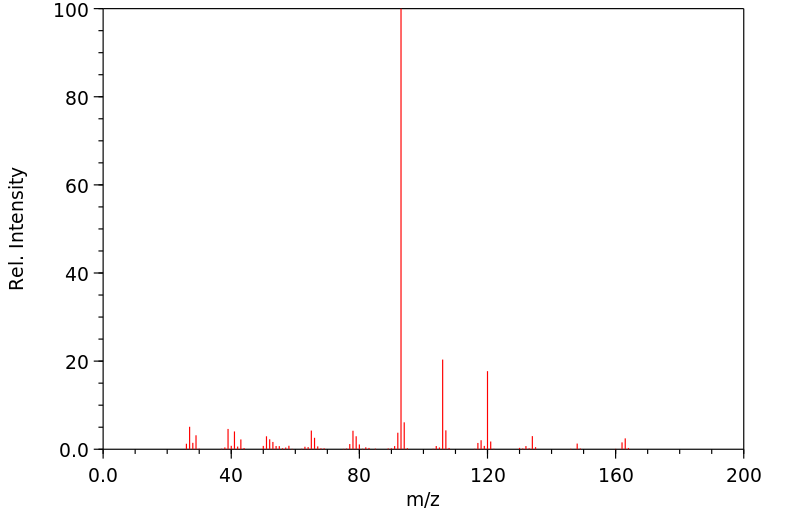2-己基吡啶 | 1129-69-7
中文名称
2-己基吡啶
中文别名
2-正己基吡啶
英文名称
2-hexylpyridine
英文别名
——
CAS
1129-69-7
化学式
C11H17N
mdl
MFCD00023552
分子量
163.263
InChiKey
NZLJDTKLZIMONR-UHFFFAOYSA-N
BEILSTEIN
——
EINECS
——
-
物化性质
-
计算性质
-
ADMET
-
安全信息
-
SDS
-
制备方法与用途
-
上下游信息
-
文献信息
-
表征谱图
-
同类化合物
-
相关功能分类
-
相关结构分类
物化性质
-
沸点:100 °C(Press: 0.1 Torr)
-
密度:0.899±0.06 g/cm3(Predicted)
-
LogP:3.766 (est)
-
稳定性/保质期:
如果按照规格使用和储存,则不会分解,也未有已知的危险反应。请避免与氧化物接触。
计算性质
-
辛醇/水分配系数(LogP):3.4
-
重原子数:12
-
可旋转键数:5
-
环数:1.0
-
sp3杂化的碳原子比例:0.545
-
拓扑面积:12.9
-
氢给体数:0
-
氢受体数:1
安全信息
-
安全说明:S26,S36/37/39
-
危险类别码:R36/37/38
-
RTECS号:UT4245000
-
海关编码:2933399090
-
危险性防范说明:P280,P305+P351+P338
-
危险性描述:H302
-
储存条件:请将贮藏器密封,并将其存放在阴凉、干燥处。确保工作环境有良好的通风或排气设施。
SDS
上下游信息
-
上游原料
中文名称 英文名称 CAS号 化学式 分子量 2-己-5-炔基-吡啶 2-hex-5-ynyl-pyridine 105905-76-8 C11H13N 159.231
反应信息
-
作为反应物:描述:2-己基吡啶 在 lithium diisopropyl amide 作用下, 以 四氢呋喃 为溶剂, 反应 4.25h, 生成 10-chloro-6-hydroxy-5-pentyl-benzo[c]quinolizinium chloride参考文献:名称:合成,SAR,晶体结构和生物学评价的苯并喹啉作为野生型和突变型囊性纤维化跨膜电导调节剂通道的激活剂。摘要:氯离子通道在体内平衡中起着重要作用,并调节细胞体积,上皮运输和电兴奋性。尽管最近在氯通道的遗传和分子方面取得了进展,但对其药理学仍知之甚少。囊性纤维化跨膜电导调节剂(CFTR)是cAMP调节的上皮氯化物通道,其突变导致囊性纤维化。在这里,我们合成了苯并[c]喹啉鎓盐和苯并[f]吲哚并[2,3-a]喹啉鎓鎓盐(MPB),并进行了SAR鉴定,以激活CFTR氯化物通道的结构基础。使用机器人和基于细胞的分析方法,对野生型CFTR和密码子551处具有甘氨酸至天冬氨酸错义突变的CFTR(G551D-CFTR)进行了合成化合物的评估。苯并[c]喹啉鎓骨架的6位上与10或7位上的氯原子缔合的羟基和5位上的烷基链的存在确定了最高的活性。最有效的产物是5-丁基-7-氯-6-羟基苯并[c]喹唑鎓氯化物(8u,MPB-104)。8u的效力是母体化合物8a(MPB-07)的100倍。DOI:10.1021/jm0308848
-
作为产物:描述:参考文献:名称:Gautier et al., Chemische Berichte, 1958, p. 415,418摘要:DOI:
文献信息
-
Iron catalyzed cross coupling reactions of aromatic compounds申请人:——公开号:US20030220498A1公开(公告)日:2003-11-27A process for the production of compounds Ar—R 1 by means of a cross-coupling reaction of an organometallic reagent R 1 —M with an aromatic or heteroaromatic substrate Ar—X catalyzed by one or several iron salts or iron complexes as catalysts or pre-catalysts, present homogeneously or heterogeneously in the reaction mixture. This new invention exhibits substantial advantages over established cross coupling methodology using palladium- or nickel complexes as the catalysts. Most notable aspects are the fact that (i) expensive and/or toxic nobel metal catalysts are replaced by cheap, stable, commercially available and toxicologically benign iron salts or iron complexes as the catalysts or pre-catalysts, (ii) commercially attractive aryl chlorides as well as various aryl sulfonates can be used as starting materials, (iii) the reaction can be performed under “ligand-free” conditons, and (iv) the reaction times are usually very short.
-
Dilithium Amides as a Modular Bis-Anionic Ligand Platform for Iron-Catalyzed Cross-Coupling作者:Peter G. N. Neate、Bufan Zhang、Jessica Conforti、William W. Brennessel、Michael L. NeidigDOI:10.1021/acs.orglett.1c02053日期:2021.8.6Dilithium amides have been developed as a bespoke and general ligand for iron-catalyzed Kumada–Tamao–Corriu cross-coupling reactions, their design taking inspiration from previous mechanistic and structural studies. They allow for the cross-coupling of alkyl Grignard reagents with sp2-hybridized electrophiles as well as aryl Grignard reagents with sp3-hybridized electrophiles. This represents a rare
-
Alkylation of Pyridines at Their 4-Positions with Styrenes plus Yttrium Reagent or Benzyl Grignard Reagents作者:Tomoya Mizumori、Takeshi Hata、Hirokazu UrabeDOI:10.1002/chem.201404635日期:2015.1.2A new regioselective alkylation of pyridines at their 4‐position was achieved with styrenes in the presence of yttrium trichloride, BuLi, and diisobutylaluminium hydride (DIBAL‐H) in THF. Alternatively, similar products were more simply prepared from pyridines and benzyl Grignard reagents. These reactions are not only a useful preparation of 4‐substituted pyridines but are also complementary to other
-
Ir<sub>4</sub>(CO)<sub>12</sub>-Catalyzed Benzylic C(sp<sup>3</sup>)–H Silylation of 2-Alkylpyridines with Hydrosilanes Leading to 2-(1-Silylalkyl)pyridines作者:Yoshiya Fukumoto、Masaya Hirano、Nao Matsubara、Naoto ChataniDOI:10.1021/acs.joc.7b02375日期:2017.12.15The iridium-catalyzed C(sp3)–H silylation of 2-alkylpyridines with hydrosilanes at the benzylic position to afford 2-(1-silylalkyl)pyridines is described. The low product yield was markedly improved by adding 3,5-dimethylpyridine. Norbornene is also an essential additive for the reaction to proceed as a hydrogen scavenger. Carbon monoxide plays an important role in the catalytic cycle as a ligand.
-
A Convenient Method for the Regioselective Synthesis of 4-Alkyl(aryl)pyridines Using Pyridinium Salts作者:Kin-ya Akiba、Y\={u}ji Iseki、Makoto WadaDOI:10.1246/bcsj.57.1994日期:1984.7(81–94%). The dihydropyridines were oxidized by oxygen to give 4-alkyl(aryl)pyridines (38–68%). Grignard reagents also reacted with 1-t-butyldimethylsilylpyridinium triflate with almost complete regioselectivity (>99%) to afford the corresponding 1,4-dihydropyridines, which were easily oxidized by oxygen to give 4-substituted pyridines in higher yields than above (58–70%).
表征谱图
-
氢谱1HNMR
-
质谱MS
-
碳谱13CNMR
-
红外IR
-
拉曼Raman
-
峰位数据
-
峰位匹配
-
表征信息
同类化合物
(S)-氨氯地平-d4
(R,S)-可替宁N-氧化物-甲基-d3
(R)-(+)-2,2'',6,6''-四甲氧基-4,4''-双(二苯基膦基)-3,3''-联吡啶(1,5-环辛二烯)铑(I)四氟硼酸盐
(R)-N'-亚硝基尼古丁
(R)-DRF053二盐酸盐
(5E)-5-[(2,5-二甲基-1-吡啶-3-基-吡咯-3-基)亚甲基]-2-亚磺酰基-1,3-噻唑烷-4-酮
(5-溴-3-吡啶基)[4-(1-吡咯烷基)-1-哌啶基]甲酮
(5-氨基-6-氰基-7-甲基[1,2]噻唑并[4,5-b]吡啶-3-甲酰胺)
(2S,2'S)-(-)-[N,N'-双(2-吡啶基甲基]-2,2'-联吡咯烷双(乙腈)铁(II)六氟锑酸盐
(2S)-2-[[[9-丙-2-基-6-[(4-吡啶-2-基苯基)甲基氨基]嘌呤-2-基]氨基]丁-1-醇
(2R,2''R)-(+)-[N,N''-双(2-吡啶基甲基)]-2,2''-联吡咯烷四盐酸盐
(1'R,2'S)-尼古丁1,1'-Di-N-氧化物
黄色素-37
麦斯明-D4
麦司明
麝香吡啶
鲁非罗尼
鲁卡他胺
高氯酸N-甲基甲基吡啶正离子
高氯酸,吡啶
高奎宁酸
马来酸溴苯那敏
马来酸氯苯那敏-D6
马来酸左氨氯地平
顺式-双(异硫氰基)(2,2'-联吡啶基-4,4'-二羧基)(4,4'-二-壬基-2'-联吡啶基)钌(II)
顺式-二氯二(4-氯吡啶)铂
顺式-二(2,2'-联吡啶)二氯铬氯化物
顺式-1-(4-甲氧基苄基)-3-羟基-5-(3-吡啶)-2-吡咯烷酮
顺-双(2,2-二吡啶)二氯化钌(II) 水合物
顺-双(2,2'-二吡啶基)二氯化钌(II)二水合物
顺-二氯二(吡啶)铂(II)
顺-二(2,2'-联吡啶)二氯化钌(II)二水合物
韦德伊斯试剂
非那吡啶
非洛地平杂质C
非洛地平
非戈替尼
非布索坦杂质66
非尼拉朵
非尼拉敏
雷索替丁
阿雷地平
阿瑞洛莫
阿扎那韦中间体
阿培利司N-6
阿伐曲波帕杂质40
间硝苯地平
间-硝苯地平
镉,二碘四(4-甲基吡啶)-
锌,二溴二[4-吡啶羧硫代酸(2-吡啶基亚甲基)酰肼]-







